In order to define the thermochemical properties of a process, it is first necessary to write a thermochemical equation that defines the actual change taking place, both in terms of the formulas of the substances involved and their physical states (temperature, pressure, and whether solid, liquid, or gaseous.
To take a very simple example, here is the complete thermochemical equation for the vaporization of water at its normal boiling point:
H2O(l, 373 K, 1 atm) → H2O(g, 373 K, 1 atm) ΔH = 40.7 kJ mol–1
The quantity 40.7 is known as the enthalpy of vaporization (often referred to as “heat of vaporization”) of liquid water.
It is essential that the following points be kept in mind when writing thermochemical equations:
• Any thermodynamic quantity such as ΔH that is associated with a thermochemical equation always refers to the number of moles of substances explicitly shown in the equation.
Thus for the synthesis of water we can write
2 H2(g) + O2(g)→ 2 H2O(l) ΔH = –572 kJ
or
H2(g) + ½ O2(g)→ H2O(l) ΔH = –286 kJ
• Thermochemical equations for reactions taking place in solution must also specify the concentrations of the dissolved species.
For example, the enthalpy of neutralization of a strong acid by a strong base is given by
H+(aq, 1M, 298 K, 1 atm) + OH–(aq, 1M, 298 K, 1 atm) →
H2O(l, 373 K, 1 atm) ΔH = —56.9 kJ mol–1
in which the abbreviation aq refers to the hydrated ions as they exist in aqueous solution. Since most thermochemical equations are written for the standard conditions of 298 K and 1 atm pressure, we can leave these quantities out if these conditions apply both before and after the reaction. If, under these same conditions, the substance is in its preferred (most stable) physical state, then the substance is said to be in its standard state.
Thus the standard state of water at 1 atm is the solid below 0°C, and the gas above 100°C. A thermochemical quantity such as ΔH that refers to reactants and products in their standard states is denoted by ΔH°.
• In the case of dissolved substances, the standard state of a solute is that in which the “effective concentration”, known as the activity, is unity.
For non-ionic solutes the activity and molarity are usually about the same for concentrations up to about 1M, but for an ionic solute this approximation is generally valid only for solutions more dilute than 0.001-0.01M, depending on electric charge and size of the particular ion.
The enthalpy change for a chemical reaction is the difference
ΔH = Hproducts – Hreactants
If the reaction in question represents the formation of one mole of the compound from its elements in their standard states.
H2(g) + ½ O2(g)→ H2O(l) ΔH = –286 kJ
then we can arbitrarily set the enthalpy of the elements to zero and write
H °reaction = Σ ΔHf °products – Σ ΔHf °reactants= –286 kJ – 0 = –268 kJ mol–1
which defines the standard enthalpy of formation of water at 298K.
The value Hf ° = –268 kJ tells us that when hydrogen and oxygen, each at a pressure of 1 atm and at 298 K (25° C) react to form 1 mole of liquid water also at 25°C and 1 atm pressure, 268 kJ will have passed from the sytstem (the reaction mixture) into the surroundings. The negative sign indicates that the reaction is exothermic: the enthalpy of the product is smaller than that of the reactants.
The standard enthalpy of formation is a fundamental property of any compound. Most chemistry textbooks contain tables of Hf ° values (usually alongside values of other thermodynamic properties) in their appendices. There are also many Web-based sources, such as the one at chemistry.about.com.
In general, the standard enthalpy change for a reaction is given by the expression
important ⇒ΔH°reaction = Σ ΔHf °products Σ ΔHf °reactants (2-1)
in which the ΣHf ° terms indicate the sums of the standard enthalpies of formations of all products and reactants. The above definition is one of the most important in chemistry because it allows us to predict the enthalpy change of any reaction without knowing any more than the standard enthalpies of formation of the products and reactants, which are widely available in tables.
The following examples illustrate some other important aspects of the standard enthalpy of formation of substances.
• The thermochemical equation defining Hf ° is always written in terms of one mole of the substance in question:
½ N2(g) + 3/2 H2(g)→ NH3(g) ΔH° = –46.1 kJ (per mole of NH3)
•The standard heat of formation of a compound is always taken in reference to the forms of the elements that are most stable at 25°C and 1 atm pressure.
A number of elements, of which sulfur and carbon are common examples, can exist in more then one solid crystalline form.
In the case of carbon, the graphite modification is the more stable form.
C(graphite) + O2(g) → CO2(g) ΔH° ≡ Hf ° = –393.5 kJ mol–1
C(diamond) + O2(g) → CO2(g) ΔH° = –395.8 kJ mol–1
• The physical state of the product of the formation reaction must be indicated explicitly if it is not the most stable one at 25°C and 1 atm pressure:
H2(g) + ½ O2(g) → H2O(aq) ΔH° ≡ Hf ° = –285.8 kJ mol–1
H2(g) + ½ O2(g) → H2O(g) ΔH° = –241.8 kJ mol–1
Other ionic enthalpies (as they are commonly known) are found by combining appropriate thermochemical equations (as explained in Section 3 below). For example, Hf° of HCl(aq) is found from the enthalpies of formation and solution of HCl(g), yielding
½H2(g) + ½Cl2(g) → HCl(aq) ΔH° ≡ Hf ° = –167 kJ mol
Because Hf° for H+(aq) is zero, this value establishes the standard enthalpy of the chloride ion.
The standard enthalpy of formation of Ca2+(aq), given by
Ca(s) + Cl2(g) → CaCl2(aq)
could then be calculated by combining other measurable quantities such as the enthalpies of formation and solution of CaCl2(s) to find Hf° for CaCl2(aq), from which Hf° of Ca2+(aq) is found by difference from that of Cl–(aq).
Tables of the resulting ionic enthalpies are widely available (see here) and are often printed in general chemistry textbooks.
C(graphite) + O2(g)→ CO2(g) ΔH° = –393.51 kJ mol–1
C(diamond) + O2(g)→ CO2(g) ΔH° = –395.40 kJ mol–1
Subtraction of the second reaction from the first (i.e., writing the second equation in reverse and adding it to the first one) yields
C(graphite) → C(diamond) ΔH° = 1.89 kJ mol–1
This principle, known as Hess’ law of independent heat summation is a direct consequence of the enthalpy being a state function. Hess’ law is one of the most powerful tools of chemistry, for it allows the change in the enthalpy (and in other thermodynamic functions) of huge numbers of chemical reactions to be predicted from a relatively small base of experimental data.
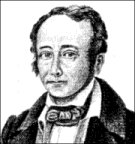 Germain Henri Hess (1802-1850) was a Swiss-born professor of chemistry at St. Petersburg, Russia. He formulated his famous law, which he discovered empirically, in 1840. Very little appears to be known about his other work in chemistry.
Germain Henri Hess (1802-1850) was a Swiss-born professor of chemistry at St. Petersburg, Russia. He formulated his famous law, which he discovered empirically, in 1840. Very little appears to be known about his other work in chemistry.
Standard enthalpies of combustion
Because most substances cannot be prepared directly from their elements, heats of formation of compounds are seldom determined by direct measurement. Instead, Hess’ law is employed to calculate enthalpies of formation from more accessible data. The most important of these are the standard enthalpies of combustion. Most elements and compounds combine with oxygen, and many of these oxidations are highly exothermic, making the measurement of their heats relatively easy.
For example, by combining the heats of combustion of carbon, hydrogen, and methane, we can obtain the standard enthalpy of formation of methane, which as we noted above, cannot be determined directly.
Use the following heat of formation/combustion information to estimate the standard heat of formation of methane CH4.
C(graphite) + O2(g) → CO2(g) ΔH° = –393 kJ mol–1(P1-1)
H2(g) + ½O2(g) → H2O(g) ΔH° = –286 kJ mol–1(P1-2)
CH4(g) + 2O2(g) → CO2(g) + 2H2O(g) ΔH° = –890 kJ mol–1(P1-3)
Solution: The standard heat of formation of methane is defined by the reaction
C(graphite) + 2H2(g) → CH4(g) ΔH° = ???(P1-4)
Our task is thus to combine the top three equations in such a way that they add up to (4).
1) Begin by noting that (3), the combustion of methane, is the only equation that contains the CH4 term, so we need to write it in reverse (not forgetting to reverse the sign of ΔH°!) so that CH4 appears as the product.
CO2(g) + 2H2O(g) → CH4(g) + 2O2(g) ΔH° = +890 kJ mol–1(P1-3Rev)
2) Since H2O does not appear in the net reaction (4), add two times (2) to cancel these out. Notice that this also cancels one of the oxygens in (3Rev):
CO2(g) + 2H2O(g) → CH4(g) + 2O2(g) ΔH° = +890 kJ mol–1(P1-3Rev)
2 H2(g) + O2(g) → 2H2O(g) ΔH° = –484 kJ mol–1(P1-2)
3) Finally, get rid of the remaining O2 and CO2 by adding (1); this also adds a needed C:
CO2(g) + 2H2O(g) → CH4(g) + 2O2(g) ΔH° = +890 kJ mol–1(P1-3Rev)
2 H2(g) + O2(g) → 2H2O(g) ΔH° = –572 kJ mol–1(P1-2)
C(graphite) + O2(g) → CO2(g) ΔH° = –393 kJ mol–1(P1-1)
4) So our creative cancelling has eliminated all except the substances that appear in (4). Just add up the enthalpy changes and we are done:
C(graphite) + 2H2(g) → CH4(g) ΔH° = ???(P1-4)
(The tablulated value is –74.6 kJ mol–1)
How are enthalpy changes determined experimentally? First, you must understand that the only thermal quantity that can be observed directly is the heat q that flows into or out of a reaction vessel, and that q is numerically equal to ΔH° only under the special condition of constant pressure. Moreover, q is equal to the standard enthalpy change only when the reactants and products are both at the same temperature, normally 25°C.
The measurement of q is generally known as calorimetry.
The most common types of calorimeters contain a known quantity of water which absorbs the heat released by the reaction. Because the specific heat capacity of water (4.184 J g–1 K–1) is known to high precision, a measurement of its temperature rise due to the reaction enables one to calculate the quantity of heat released.
The calorimeter constant
In all but the very simplest calorimeters, some of the heat released by the reaction is absorbed by the components of the calorimeter itself. It is therefore necessary to "calibrate" the calorimeter by measuring the temperature change that results from the introduction of a known quantity of heat. The resulting calorimeter constant, expressed in J K–1, can be regarded as the “heat capacity of the calorimeter”. The known source of heat is usually produced by passing a known quantity of electric current through a resistor within the calorimeter, but it can be measured by other means as described in the following problem example.
For reactions that can be initiated by combining two solutions, the temperature rise of the solution itself can provide an approximate value of the reaction enthalpy if we assume that the heat capacity of the solution is close to that of the pure water — which will be nearly true if the solutions are dilute.
For example, a very simple calorimetric determination of the standard enthalpy of the reaction H+(aq) + OH–(aq) → H2O(l) could be carried out by combining equal volumes of 0.1M solutions of HCl and of NaOH initially at 25°C. Since this reaction is exothermic, a quantity of heat q will be released into the solution. From the tmperature rise and the specific heat of water, we obtain the number of joules of heat released into each gram of the solution, and q can then be calculated from the mass of the solution. Since the entire process is carried out at constant pressure, we have ΔH° = q.
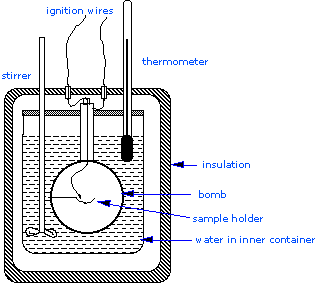
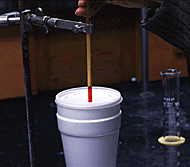
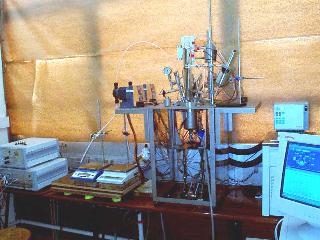
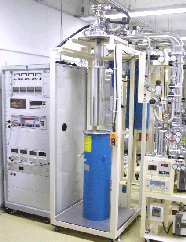
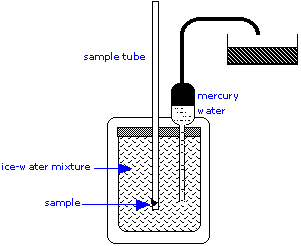 The ice calorimeter is an important tool for measuring the heat capacities of liquids and solids, as well as the heats of certain reactions. This simple yet ingenious apparatus is essentially a device for measuring the change in volume due to melting of ice. To measure a heat capacity, a warm sample is placed in the inner compartment, which is surrounded by a mixture of ice and water.
The ice calorimeter is an important tool for measuring the heat capacities of liquids and solids, as well as the heats of certain reactions. This simple yet ingenious apparatus is essentially a device for measuring the change in volume due to melting of ice. To measure a heat capacity, a warm sample is placed in the inner compartment, which is surrounded by a mixture of ice and water. 